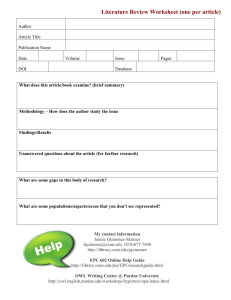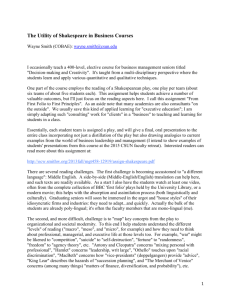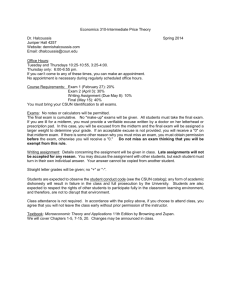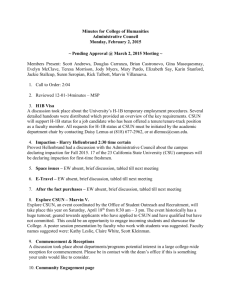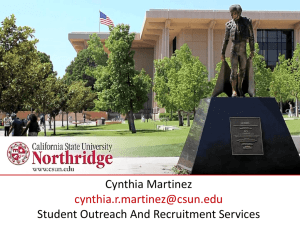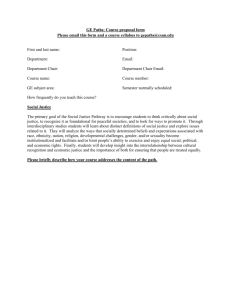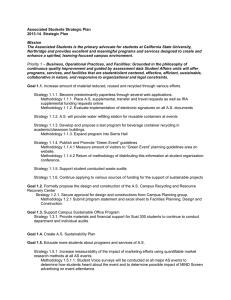Introduction to Systems Engineering Course
advertisement
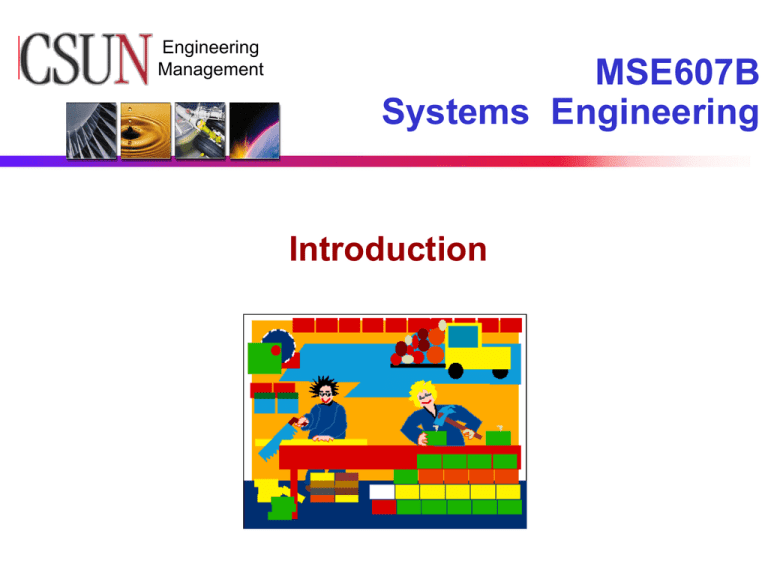
CSUN Engineering Management MSE607B Systems Engineering Introduction Learning Objectives Give an overview of concepts and methods of systems engineering and management • Considerations of life cycles, requirements, and configuration and cost management Standards, metrics, architectures, integration, and evaluation will be discussed Structured methods, decision analysis, and quality engineering foundations are emphasized Case studies from a variety of industrial contexts are presented and discussed Background and Purpose System engineering addresses various needs to be more effective and efficient in: • Development and acquisition of new systems • Operation and support of systems already in use Survey of relevant tools and techniques • Their relationships to effective systems engineering management Textbook System Engineering Management, third edition (2004) by Blanchard, Benjamin S New York: John Wiley & Sons, Inc. Hardcover List Price: $110.00 ISBN: 0-471-29176-5 Superbookdeals.com $64.78 (new) Amazon.com $100.06 (new) Half.com $60.00 (used) Matador Bookstore $88.25 (used) $117.50 (new) Contact Info David Shternberg • BS Manufacturing Systems Engineering • MS Manufacturing Systems Engineering & Management • General Manager, Maintco Corporation, Burbank E-mail Address (use all three) • CSUN - david.shternberg@csun.edu • Work - david@maintco.com • Home – ds823@aol.com Work 818-655-6401 Cell 818-521-0751 Meeting by appointment only 6-7PM EA1308 My Work Experience Israeli Air Force • F-16 Mechanic 1980-1981 • F-16 Mechanical Systems Instructor 1981-1984 Israeli Aircraft Industries 1984-1986 • Ground test inspector CRANE Hydro-Aire, Burbank CA 1986-2003 • Mfg Engineer, Producibility Mgr, Lean & Cont Improvement Mgr Eaton Aerospace, Los Angeles Jan-2004 - July 2005 • Manufacturing Manager • Mfg Eng & Fabrication Focus Factory Manager • Manufacturing and Sustaining Engineering Manager Maintco Corporation, Burbank, Aug-2005 – July 2006 • General Manager Eaton Aerospace, Los Angeles July-2006 - Present • Manufacturing Engineering Manager My Academic Records Holtz Academy of Aviation Technology, Tel-Aviv, Israel 1975-1980 • Certified Aircraft Technician • Associate Engineer Santa Monica College 1989-1993 • AA Degree California State University, Northridge 1994-1999 • BS Mfg Systems Engineering California State University, Northridge 2001-2003 • MS Mfg Systems Engineering & Management Part-time MSEM faculty member since Jan 2004 Course E-mail List To promote email as an effective communication mechanism for both faculty and students, a mailing list for MSE607B class was established. Email messages to this class mailing list and each member of the list will receive a copy of those messages. Two names (email aliases) for the class mailing list created, either of can be used: • • The first alias is based on the class number (aka ticket number) classFA06.11768-c@csun.edu The second alias is based on the subject, catalog number, and section fa06.mse607b.01c@csun.edu This list was populated with my email address (shternberg@csun.edu) and with each student's campus email address that was enrolled in this class The list is automatically updated on a weekly basis (until census) to reflect the current enrollment of the class • For the list to be effective, all students must activate their campus email account and monitor their email. • • No need to maintain the list. Students may activate their campus email by logging into the Portal (https://www.csun.edu/portal). If students would prefer to receive campus email to a non-campus email account such as Yahoo or Hotmail, they may configure mail-forwarding to that account via the account maintenance web site (https://www.csun.edu/account). To minimize potential of receiving spam, it is configured it to be a "closed" list. • • As a closed list, only members of the list may post messages to it. Consequently, students may send email to this list using only their campus email address Class Material Website URL • http://www.csun.edu/~shternberg/mse607b.htm MSE607B Course Page • Login: shternberg • Password: mse607b Class Syllabus PowerPoint Presentations Schedule of classes My E-mail and phone numbers Reading Assignments Essential for interaction and understanding Read assigned chapter prior to class Prepare to discuss issues/questions Preparation will make the course more interesting Pop-quiz may be given Next week’s assignment • Chapter 1 – Introduction to Systems Engineering (pp. 1-45) Course Performance Evaluation Structure 25 % 25 % 35 % 5 % 10 % Mid-Term Chapters 1-4 Final Exam (comprehensive) Team Research Project Attendance and professionalism Participation and active learning (based in part on Partnership Peer Review Reports) Letter-Grade Scale Plus/Minus will be used Score Grade Score Grade 90-100 A 70-74 C 88-89 A- 68-69 C- 85-87 B+ 60-67 D 80-84 B 58-59 D- 78-79 B- 0-57 F 75-77 C+ Standard Operating Procedures Encouraged to maintain personal and professional standards consistent with The Fundamental Principles of the Code of Ethics of the Accreditation Board for Engineering and Technology (ABET): Engineers uphold and advance the integrity, honor and dignity of the engineering profession by: • Using their knowledge and skill for the enhancement of human welfare • Being honest and impartial, and serving with fidelity the public, their employers and clients • Striving to increase the competence and prestige of the engineering profession • Supporting the professional technical societies of their disciplines Student Roles & Responsibilities Attend class sessions and to be prompt Be a team player Submit original work only • I was a student too… Be considerate and respectful of one another Get the job done right and on time Budgeting 5-6 hours per week for this course, in addition to class attendance, is not unreasonable Course Overview Chapter 1 Introduction to Systems Engineering Abbreviated introduction to some of the key terms and definitions inherent in the discussions throughout subsequent chapters • • • • • Systems System Analysis System Science System Engineering Life Cycle Natural introduction to the system engineering process discussed in chapter 2 Chapter 2 The System Engineering Process Relates terms and definitions introduced in chapter 1 to the system life cycle Establishes a baseline to provide a frame of reference for the discussion of: • • • • Individual design disciplines Design methods, and The activities associated with system engineering The system engineering process is presented in the form of an overview The concepts introduced here are amplified In subsequent chapters, to a much greater degree Necessary prerequisite to the information presented later Chapter 3 System Design Requirements The design requirements through the development of specifications Requirements for reliability, maintainability, supportability, quality, and alike • Few design disciplines such as these are discussed Review some of the details as they pertain to individual design disciplines Introduction to a select sample of disciplines Importance of design integration through application of system engineering methods Chapter 4 Engineering Design Methods and Tools Briefly highlight some of the recent concepts in design • Conventional design practices • Analytical methods The role of • Electric Commerce (EC) • Information Technology (IT) • The Internet Current Design Technologies and Tools • Simulation • Rapid Prototyping • Mock-ups Computer Aided Design (CAD) Computer-Aided Manufacturing (CAM) Computer-Aided Support (CAS) System engineering objectives as they relate to current design methods Chapter 5 Design Review and Evaluation Explain the basic philosophy of design evolution Describe the evaluation methods Explain the informal and formal design reviews Explain the feedback and corrective-action loop associated with these activities Chapter 6 System Engineering Program Planning Introduce system engineering program planning • First step in system management. Material presented in this module leads into the discussion of • The organization for system engineering in module 7 • System engineering program evaluation in module 8 Chapter 7 Organization for System Engineering Explain the basic philosophy of design evolution Explain the different types of organizational structures Discuss advantages and disadvantages of each structure from a generic perspective Emphasize the system engineering organization, its functions, organizational interfaces, and the staffing needed Explain the implementation of Integrated Product and Process Development (IPPD) configuration Explain customer, producer, and supplier relationships Discuss human resources requirements Chapter 8 System Engineering Program Evaluation Explain the evaluation requirements of systems engineering program Describe benchmarking best practices in system engineering Explain the evaluation of system engineering organization Explain program reporting, feedback and control Homework Assignment Read Chapter 1 Introduction to System Engineering • Pages 1-44 Questions? Comments?
